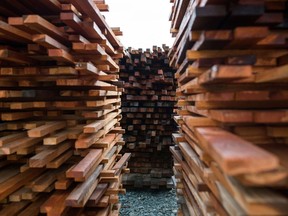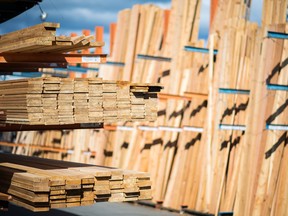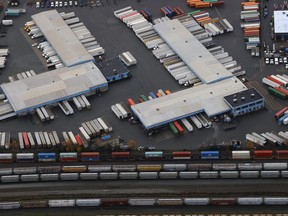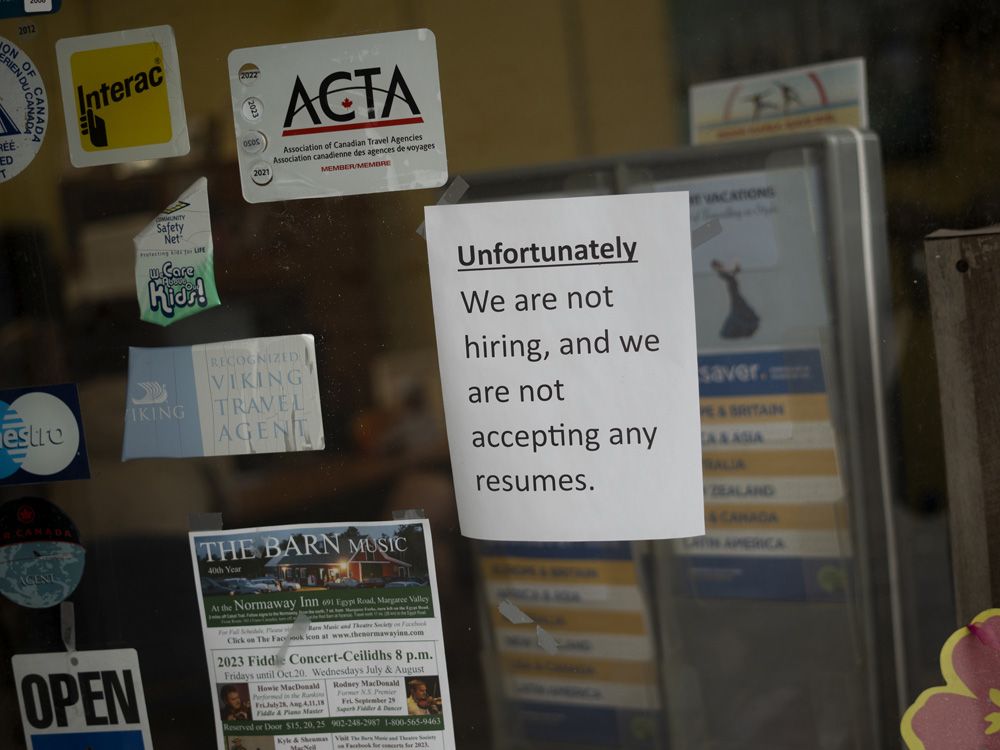‘Extreme’ supply chain snafus hit lumber industry, forcing output curbs as prices hover near record

Canfor shifts to four-day workweek after running out of room to pile boards amid railcar shortage

Article content
The strangest lumber market in memory keeps getting stranger.
Advertisement 2
Story continues below
Article content
Canfor Corp., one of North America’s biggest lumber producers, said this week that it will shift to a four-day workweek at most of its 11 mills in British Columbia and Alberta starting April 4; not because of inadequate demand, but because it’s run out of room to pile the boards that customers are ordering at a startling rate.
“We are experiencing extreme supply chain challenges,” Don Kayne, chief executive of Vancouver-based Canfor, said in a press release on March 31. “It has become imperative to reduce operating schedules to address our unsustainable inventory levels.”
The main issue appears to be a shortage of rail cars in Western Canada, where Canadian National Railway Co. and Canadian Pacific Railway Ltd. are struggling to keep up with the post-pandemic surge in demand for virtually every commodity that Canada exports in bulk. That means companies have been piling up inventory, as they wait for the railways to clear their backlogs. Things got so bad for Canfor that it ran out of space; the company said the new production schedule will reduce output by at least 100 million board feet at a time when lumber prices are sitting near an all-time high.
Advertisement 3
Story continues below
Article content
Other lumber producers in the region face a similar conundrum, and have reduced operating schedules at their mills, although not all have publicly disclosed it yet, according to several sources, who spoke on condition of anonymity.

The situation shows how supply chain snarls continue to disrupt the economy and contribute to a growing chasm between supply and demand that has stoked inflation to its hottest in more than 30 years. The Bank of Canada, which says the extreme price pressure is mainly the result of a series of supply issues, nonetheless indicated last week that it intends to accelerate interest-rate increases to get the situation under control. “The invasion of Ukraine is adding to inflationary pressures around the world and in Canada,” deputy governor Sharon Kozicki said in a speech on March 25. “This is primarily because it has caused global prices for oil and other commodities to surge. The result is inflation in the near term that is expected to be higher than we projected in January.”
Advertisement 4
Story continues below
Article content
Lumber has become a symbol of the chaos over the past couple of years. The initial COVID lockdowns came as many mills were scaling back production, but homeowners with nowhere to go splurged on renovations, resulting in an unanticipated surge in demand for construction materials, sending prices to a record high.
Sawmills ramped up production, which tugged record prices back to earth for a little while. Then, prices surged anew as Canadian and U.S. housing markets took off again.
Data about pricing varies, but in 2020, benchmark southern lumber reached $1,169 per thousand board feet, nearly double the previous all-time high $589, while western lumber prices were close behind, according to an investor presentation on the website of Quesnel, B.C.-based West Fraser Timber Co. Ltd., Canada’s largest lumber company by market capitalization. It was great for West Fraser and its shareholders: the same presentation included a chart suggesting the company’s profit margins from North American lumber spiked to an all-time high above 25 per cent in 2020.
Advertisement 5
Story continues below
Article content
In 2021, prices surged to yet another record of around $1,600 per thousand board feet. They have since fallen below $1,300, but remain up by more than 20 per cent year over year, according to Random Lengths, a trade industry publication. The newest supply disruption — the backup of production at sawmills — could push prices back towards their peak.
“I’ve done this 35 years, and this is the craziest I’ve ever seen,” said Mark Wilde, an analyst at BMO Capital Markets.
I’ve done this 35 years, and this is the craziest I’ve ever seen
Mark Wilde, analyst, BMO Capital Markets
The drop to a four-day week was only the latest evidence of Canfor’s inventory problems. A day before the announcement, a subsidiary, Canfor Pulp Products Inc., said that it was extending the closure of its Taylor mill in B.C. by at least six weeks, citing transportation issues. Unlike lumber, pulp cannot be stored outside.
Advertisement 6
Story continues below
Article content
If the price spike in 2020 was caused by pandemic-related shutdowns and mistaken demand projections, the more recent spike was caused by a number of factors, including transportation snarls out of Western Canada.
Severe flooding and wildfires throughout the interior of British Columbia left lumber producers, but also companies such as Teck Resources Ltd., which mines steelmaking coal in the region, unable to transport their product to market. That caused inventory levels to mount at various companies.
While some of the bridges and roads were repaired, analysts noted that rail transport always declines in the winter because icy conditions make it unsafe to operate as many rail cars as during other seasons.
Advertisement 7
Story continues below
Article content
“Definitely this transportation issue is one of the reasons why prices are at current levels,” said Paul Quinn, an analyst with RBC Capital Markets who covers the lumber market.
But Quinn said it’s not clear what happens now, as spring, the beginning of the homebuilding season, kicks in and demand begins to ratchet up.

Ordinarily, prices would rise with demand, but many buyers placed their orders and locked in prices months ago and now are waiting to receive their orders.
“Demand should actually turn up significantly,” said Quinn. “So the question is do prices stabilize and rally again? That’s the big question and it’s hard to judge.”
Whether the rail transportation issues in Western Canada are resolved is a key question.
Advertisement 8
Story continues below
Article content
A spokesperson for CN acknowledged that “extreme weather in Western Canada earlier this year, along with ongoing North America wide supply chain challenges have impacted cycle times for railcars,” but declined to offer any information about the scale of the problem or a timeline for when it may be resolved.
CP didn’t immediately respond to a request for comment.
Ultimately, the solution to high prices is always high prices
Mark Wilde, analyst, BMO Capital Markets
In February, Teck’s chief executive, Don Lindsay, told analysts on an earnings call that it had high steelmaking coal inventories at its mine sites. On March 31, the company confirmed that stockpiles remain at record-high levels, and added that it is working with rail companies, and expects to recover delayed sales in the first half of 2022.
In the background, there’s a larger issue that’s also affecting lumber prices in North America as western Canadian lumber producers scale back their operations in B.C. and plow their profits into building new operations in the U.S. South.
Advertisement 9
Story continues below
Article content
“B.C. continues to be a challenging jurisdiction to operate in … as we enter the post-mountain pine beetle era,” Kayne said on a call with financial analysts on March 2, referring to the invasive pest that decimated the province’s forests and has forced lumber companies to source more of their trees, or in industry parlance ‘fibre,’ from other regions.
Whether the drop off in production from B.C. can be offset by new production from the U.S. South is one factor that will affect pricing; but demand is also being affected by strong North American housing starts, said Wilde, the BMO analyst.
-

Lumber extends rally on supply, ‘unprecedented’ transport snags
-

Lumber is soaring again thanks to supply snags from B.C. floods
-

‘Unprecedented collapse’ in lumber prices forces one Canadian sawmill to curb production
-

‘Massive corrective free fall’: Lumber wipes out all its 2021 gains after record boom
All these factors have contributed to extreme price volatility for lumber during recent years, which has always been a volatile market, he said.
At the moment, everyone is watching to see whether high lumber leads to demand destruction and causes a price correction or whether prices remain high.
“Ultimately, the solution to high prices is always high prices,” Wilde said. “And right now we’ve got high prices, and you know, the solution is in the pipeline.”
• Email: gfriedman@postmedia.com | Twitter: GabeFriedz
Advertisement
Story continues below









